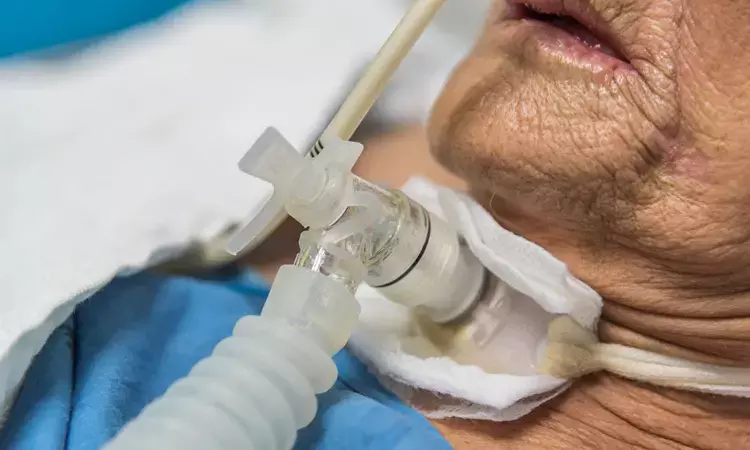- Home
- Medical news & Guidelines
- Anesthesiology
- Cardiology and CTVS
- Critical Care
- Dentistry
- Dermatology
- Diabetes and Endocrinology
- ENT
- Gastroenterology
- Medicine
- Nephrology
- Neurology
- Obstretics-Gynaecology
- Oncology
- Ophthalmology
- Orthopaedics
- Pediatrics-Neonatology
- Psychiatry
- Pulmonology
- Radiology
- Surgery
- Urology
- Laboratory Medicine
- Diet
- Nursing
- Paramedical
- Physiotherapy
- Health news
- Fact Check
- Bone Health Fact Check
- Brain Health Fact Check
- Cancer Related Fact Check
- Child Care Fact Check
- Dental and oral health fact check
- Diabetes and metabolic health fact check
- Diet and Nutrition Fact Check
- Eye and ENT Care Fact Check
- Fitness fact check
- Gut health fact check
- Heart health fact check
- Kidney health fact check
- Medical education fact check
- Men's health fact check
- Respiratory fact check
- Skin and hair care fact check
- Vaccine and Immunization fact check
- Women's health fact check
- AYUSH
- State News
- Andaman and Nicobar Islands
- Andhra Pradesh
- Arunachal Pradesh
- Assam
- Bihar
- Chandigarh
- Chattisgarh
- Dadra and Nagar Haveli
- Daman and Diu
- Delhi
- Goa
- Gujarat
- Haryana
- Himachal Pradesh
- Jammu & Kashmir
- Jharkhand
- Karnataka
- Kerala
- Ladakh
- Lakshadweep
- Madhya Pradesh
- Maharashtra
- Manipur
- Meghalaya
- Mizoram
- Nagaland
- Odisha
- Puducherry
- Punjab
- Rajasthan
- Sikkim
- Tamil Nadu
- Telangana
- Tripura
- Uttar Pradesh
- Uttrakhand
- West Bengal
- Medical Education
- Industry
Study evaluates Early vs. Late Tracheostomy and Bacterial Infections in COVID-19 ICU Patients

The COVID-19 global pandemic had a substantial effect on healthcare, particularly in critical care settings. Recent study examined the impact of early versus late tracheostomy on bacterial infections in COVID-19 patients requiring mechanical ventilation in the intensive care unit (ICU). The researchers conducted a retrospective single-center study at the Royal Medical Services Military Hospital, including COVID-19 patients who underwent tracheostomy and were admitted to the ICU from March 2020 to March 2022.
Comparison of Early versus Late Tracheostomy
The primary objective was to compare the incidence of ventilator-associated pneumonia between patients who underwent early tracheostomy (within 14 days) and late tracheostomy (more than 14 days after starting mechanical ventilation). The secondary objective was to assess the time required to wean from mechanical ventilation between the two groups.
The study included 36 patients, with no statistically significant differences in baseline characteristics between the early and late tracheostomy groups. The findings showed no significant association between the timing of tracheostomy and the incidence of bacterial infections, complications, or outcomes. Mortality was higher in the early tracheostomy group, with nine deaths compared to seven in the late tracheostomy group, but the difference was not statistically significant.
Association with Specific Bacterial Infections
Interestingly, the study found that infection with Acinetobacter baumannii was associated with a statistically significant lower mortality rate, with 75% of affected patients surviving post-tracheostomy. In contrast, infections with other bacteria, such as Pseudomonas aeruginosa, Stenotrophomonas maltophilia, and Klebsiella pneumonia, did not show significant differences in survival rates.
Conclusion and Implications
The researchers concluded that the timing of tracheostomy does not significantly impact the incidence of bacterial pneumonia or other complications in COVID-19 patients requiring mechanical ventilation. These results support the need for personalized decision-making when conducting tracheostomies. Further research is necessary to determine the impacts of tracheostomy timing on patient outcomes more definitively.
Key Points
The 3 key points of the research article are:
1. The study examined the impact of early versus late tracheostomy on bacterial infections in COVID-19 patients requiring mechanical ventilation in the intensive care unit (ICU). The primary objective was to compare the incidence of ventilator-associated pneumonia between patients who underwent early tracheostomy (within 14 days) and late tracheostomy (more than 14 days after starting mechanical ventilation). The secondary objective was to assess the time required to wean from mechanical ventilation between the two groups.
2. The findings showed no significant association between the timing of tracheostomy and the incidence of bacterial infections, complications, or outcomes. Mortality was higher in the early tracheostomy group, but the difference was not statistically significant. Interestingly, the study found that infection with Acinetobacter baumannii was associated with a statistically significant lower mortality rate, while infections with other bacteria, such as Pseudomonas aeruginosa, Stenotrophomonas maltophilia, and Klebsiella pneumonia, did not show significant differences in survival rates.
3. The researchers concluded that the timing of tracheostomy does not significantly impact the incidence of bacterial pneumonia or other complications in COVID-19 patients requiring mechanical ventilation. These results support the need for personalized decision-making when conducting tracheostomies, and further research is necessary to determine the impacts of tracheostomy timing on patient outcomes more definitively.
Reference –
Alkoheji H, Alabbasi L, Aldoseri M S, et al. (July 03, 2024) Clinical Outcomes of Early vs. Late Tracheostomy in Ventilated COVID-19 Patients. Cureus 16(7): e63757. DOI 10.7759/cureus.63757
MBBS, MD (Anaesthesiology), FNB (Cardiac Anaesthesiology)
Dr Monish Raut is a practicing Cardiac Anesthesiologist. He completed his MBBS at Government Medical College, Nagpur, and pursued his MD in Anesthesiology at BJ Medical College, Pune. Further specializing in Cardiac Anesthesiology, Dr Raut earned his FNB in Cardiac Anesthesiology from Sir Ganga Ram Hospital, Delhi.


